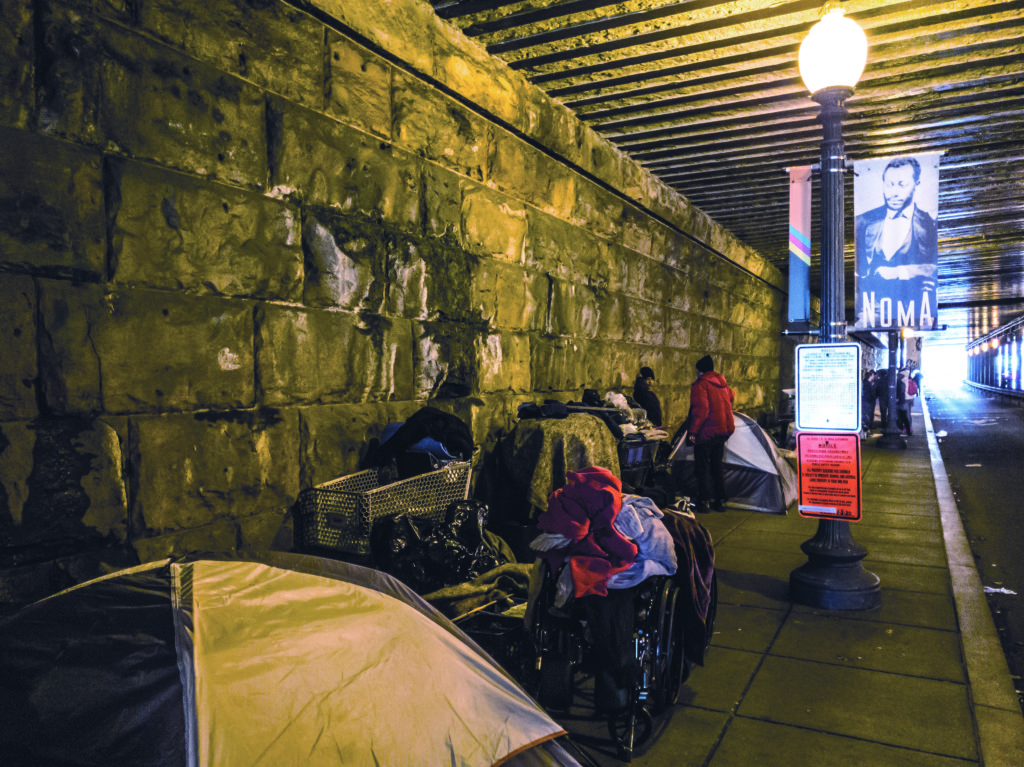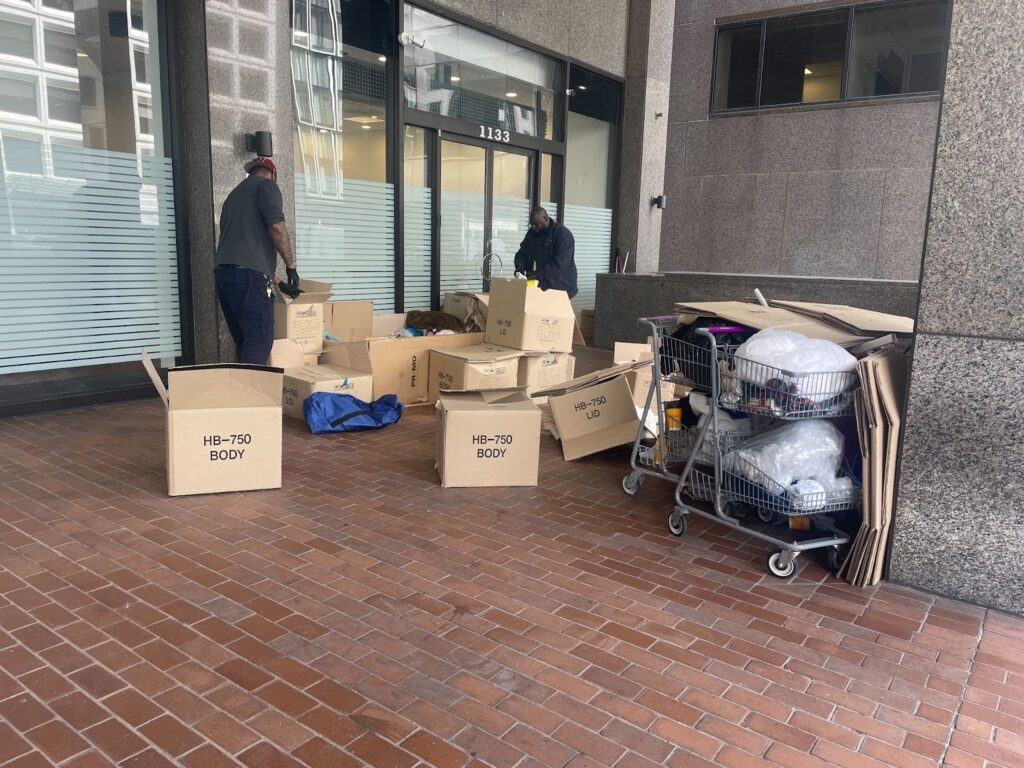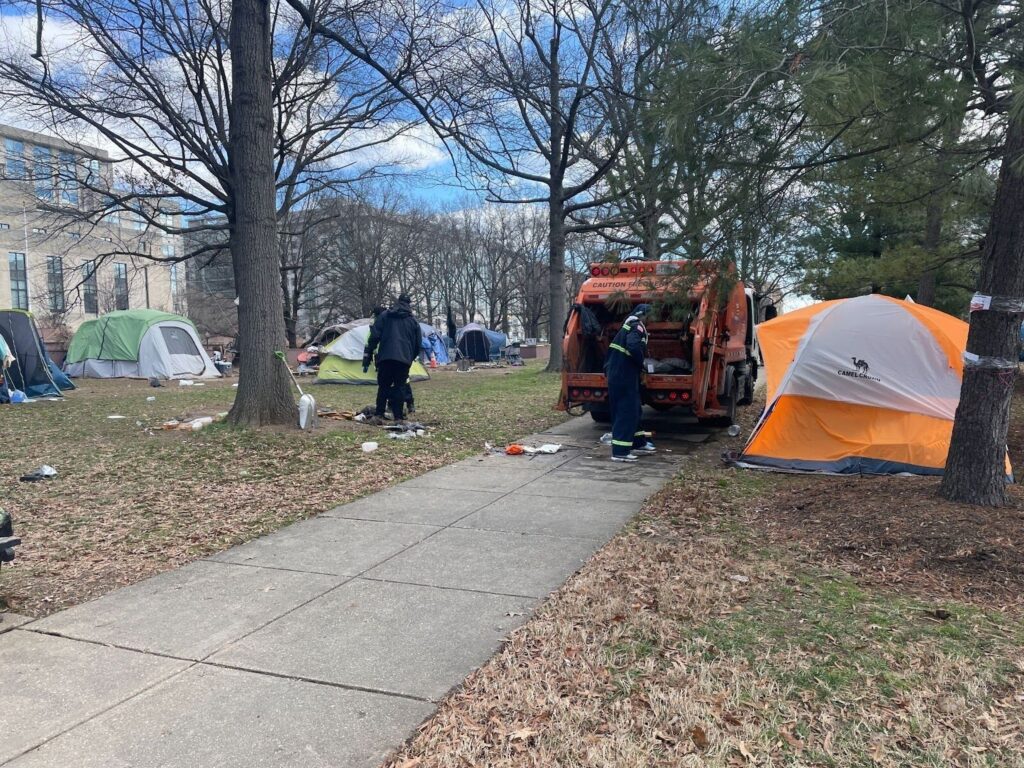With each box, duffel bag, and dresser drawer, the stack of belongings accumulating around the corner from the K St encampment grew taller. Volunteers, homeless residents helping their neighbors, and even reporters at times joined the effort. Among a collection of items belonging to encampment resident Michael Harris were plastic boxes filled with toiletries and clothing, a pair of glasses, and a copy of “How to Win Friends and Influence People,” which Harris said needed to go back to the library.
Only a few residents and their belongings were still under the underpass between First and 2nd Streets NE on Thursday, Jan. 16, the morning of the scheduled clean-up.
Aaron Bernier-Garland, an encampment resident who said he’s been homeless off and on for five years, was planning to relocate with his puppy, Buttercup, to the L Street encampment, as were Harris and other homeless residents of K Street.

The K, L, and M Street underpasses near Union Station have served as shelter to a fluctuating number of people for years, most of whom utilize tents. The Office of the Deputy Mayor of Health and Human Services coordinates the cleaning of a portion of these sites every few weeks; there were 36 such cleanups in 2018, according to city data.
What made Jan. 16 unique was the new policy that had been posted for K Street; it stated that the sidewalks of the underpass must remain clear to ensure unobstructed passage for pedestrians and any personal property that was returned to the area would be disposed of immediately.
Kim Trim, a resident of the District, said she visited the encampment at Christmastime to distribute scarves and gloves and had not been aware there would be an eviction until she drove by as the operation was wrapping up. She said she didn’t think there would be enough room in the L and M Street underpasses for the evicted K street residents. She expressed anger at the effects of gentrification on people in the NoMa area.
“You can tell that this [encampment] is families, people that work, that are just on hard times. Gentrification does that,” Trim said. “I mean, I wish everyone could afford $2,000 rent for a damn 2,000 square feet. But that’s not the real world. I’m pissed.”
Ward 1 Councilmember Brianne Nadeau visited the K Street encampment as the cleanup took place. She was the only elected leader to do so. Nadeau oversees homeless services in her role as chair of the D.C. Council’s Committee on Human Services but does not directly oversee cleanups. It was her first visit to the site, motivated, she said, by a desire to stand in solidarity with the homeless residents. “I really wanted to bear witness to the process and ensure that everybody’s rights were respected,” Nadeau said.
The language used for the new policy on K Street was first mentioned publicly in an Aug. 21 open letter posted on the NoMa Business Improvement District (BID)’s website calling on the city to protect the rights of NoMa residents to safely navigate the neighborhood. The letter described how the presence of homeless residents and their tents in the underpasses at times forced pedestrians to walk in the street in order to navigate through the underpass. The letter also described the presence of human urine and feces and rotting food in the encampments.
“It is essential that something be done to recognize and protect the right of D.C. residents, workers, and visitors to safely use and pass through public space in NoMa,” NoMa BID President Robin-Eve Jasper wrote in the letter.

Jessica Smith, a policy analyst for the Office of the Deputy Mayor of Health and Human Services, said at a community meeting two nights before the eviction that the sidewalks on K Street are much narrower than those on M Street and L Street and don’t allow adequate space for both tents and passersby, particularly for people with strollers, in wheelchairs, or with other reasons to need extra space.
Orange signs had been hung on light posts in the underpass on Jan. 2 warning residents that any belongings left under the bridge on pedestrian passageways would be “subject to immediate removal and disposal.” The community meeting aimed to answer questions about the policy and see that attendees had a plan for where they would move and how they would get there.
[Read more: Community meeting aims to prepare K Street encampment residents for eviction]
The next day, employees of the Office of the Deputy Mayor of Health and Human Services (DMHHS) walked along the K Street underpass encampment offering flyers with information for residents who were expected to move before the cleanup that was scheduled for the next morning. The employees declined to comment for this article and declined to provide a copy of the materials they were distributing.
Patricia, a K St encampment resident who was still in her tent on the morning before the eviction, described alternatives to kicking the residents out. One was mandating smaller tents. Another was the development of basic infrastructure for use of the homeless residents and the general public, noting that there are no trash cans along the underpass and few public bathrooms in the entire city. “If they’d do those things, we would have access to a bathroom, we would have access to a trash can. These are all things they should provide for the public to use,” Patricia said.
The day before the cleanup, Patricia said she and her tent mate knew they would have to move but did not know where they would go. To her, the notices were not enough. “We learned we would have to move from a cheap piece of paper and two signs. They said that they were gonna clear us out and make us move if we aren’t gone by such and such date,” she said. “Essentially treating us like garbage.”
The new policy in the K Street underpass is likely just the beginning of a larger reckoning in the District over encampments, Nadeau said.
“This obviously is a hot button issue in NoMa, one that has the potential of becoming a broader issue with encampments in the District,” Nadeau said. “There appears to be some uncertainty as to how these issues will play out further. It will be interesting to see what details will come out during the year, but for homeless residents of K Street in NoMa, it appears as if the journey has just begun.”
Kabraknai Bonds, a former resident of the K Street underpass, said she wants to provide representation for encampment residents as the political situation evolves.
Over the years, the NoMa neighborhood has undergone rapid development and an influx of new residents. Bonds said there are large apartment buildings on either side of each underpass in the area and none have offered to help the people suffering on the street to find a place to live. Her residual frustrations have driven Bonds to run for an Advisory Neighborhood Commissioner seat.
Bonds moved to the encampment after living in a shelter and feeling it was making her situation worse. She said that when she moved to the underpass the community immediately took her in as family. “They think least of us,” she said. “They think we don’t know what an ANC is or what a petition is. You want to play government games? We can play them back.”
Brandon Campbell, a former K Street resident, spent Wednesday night relocating. As Street Sense Media previously reported, Campbell had tried moving to both L Street and M Street before the city held its community meeting; he said neither move had a satisfactory outcome: on one street, his tent had been cut up to show he was not welcome and on the other, he was also unwelcome and had been antagonized into a fight.

Another man who was moving from K Street on Jan. 16 said someone had urinated on his tent and belongings when he tried to move to another underpass. He said he was left to find another solution with only his wallet and the clothes on his back.
Community organizations such as HIPS, Black Lives Matter, and The Peace House had recruited many volunteers to help K Street residents move the night before the cleanup. The volunteers were helping people relocate as late as 2 a.m. Thursday, according to Campbell. “Last night was beautiful,” he said. “The homeless people that are advocates, that‘s honestly what’s helping us.”
A labor-intensive part of the move involved setting up wooden pallets for people to pitch their tents on to keep them dry. Residents familiar with the underpasses said the L Street bridge leaks significantly and the sidewalks flood, unlike K Street.
Most people had moved by the time of the scheduled cleanup Thursday morning. But several still had not and two tried to resist being forced out. More volunteers from faith communities and nonprofits such as Miriam’s Kitchen, HIPS again, and Pathways to Housing were present to help people transport their belongings elsewhere.
Though he had successfully moved again, Campbell remained wary of wearing out his welcome with new neighbors. Adding tension to the overcrowded situation, the city moved on after completing the permanent sweep of the K Street camp to conduct a standard cleanup in the M Street underpass. Earlier that morning, advocates had reported the city would only collect trash on L and M Streets in order to give people who had just moved from K Street a break. “We’ve only been residents here like for three or four hours. Already they want us to move,” Campbell said.
At the Jan. 14 community meeting, Smith of the deputy mayor’s office said repeatedly that it was not the city’s recommendation or intention that people living in the K Street underpass move to L and M Streets. However, attendees at the meeting, including Campbell, said they had nowhere else to go without transportation assistance. While moving on the day of the cleanup, several former K Street residents said they worried the L St. and M St. underpasses were intentionally being allowed to become overcrowded with K St. residents in order to give the city a specific reason to justify banning tents in those locations, too.

Aaron Howe, a PhD candidate from American University who did ethnographic research with the NoMa tent communities and who was present for the Jan. 16 eviction wrote on Twitter that “One couple moved all their stuff from K all the way to M and ended up getting their tent and a few bags thrown out thinking they would be safe on M, not knowing the ‘standard disposition’ was still in effect for M. They are now without shelter as winter weather approaches.” Howe later wrote that HIPS had helped obtain a tent for the couple.
Campbell made it clear that even though the situation is difficult, underpass residents are complying with what is being asked of them. Although Campbell, Bonds, and others expressed frustration with a lack of support from the city to carry out relocations or maintain cleanliness in these spaces, they feel that there is concern and compassion from community organizations and many housed neighbors.
When asked if the Jan. 16 cleanup was done fairly, Nadeau said It seemed that way to her and that she would wait to see what others have to say. Even officials like her are unsure of the details of the pedestrian passageway policy that was put into effect on K Street.
When asked what is defined as a pedestrian passageway, Nadeau replied, “I was told that everything on this block from the curb to the wall is a pedestrian passageway.”
The councilmember said she is asking the mayor to brief the full council on the new policy and any updates made to the encampment protocol. “I think it’s important that people know what the rules are and what their rights are,” Nadeau said.








